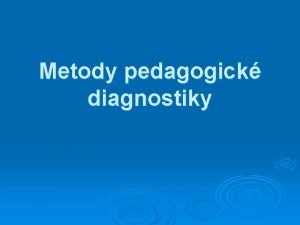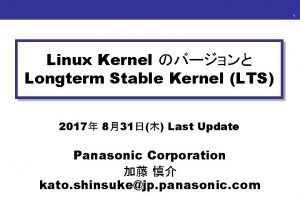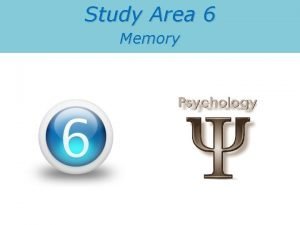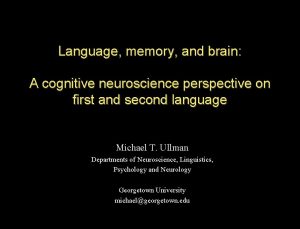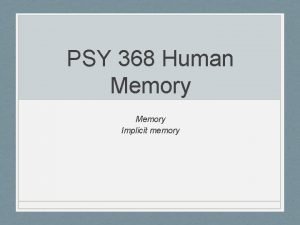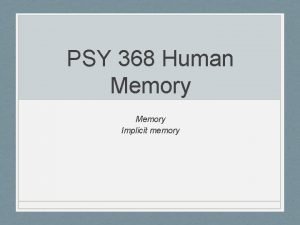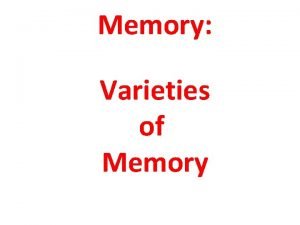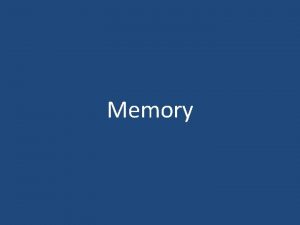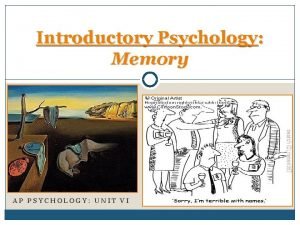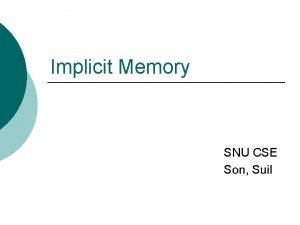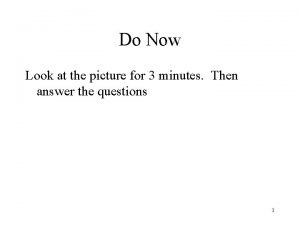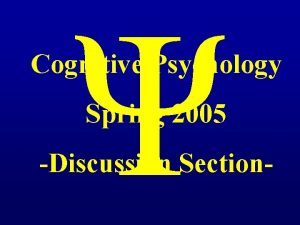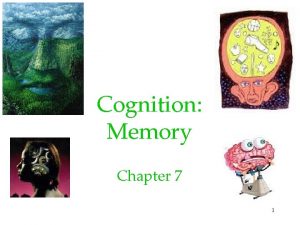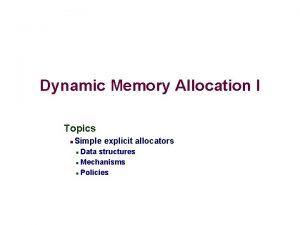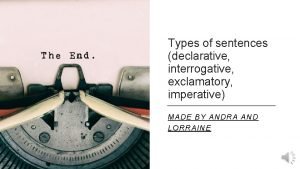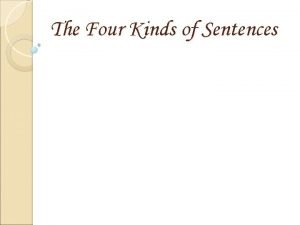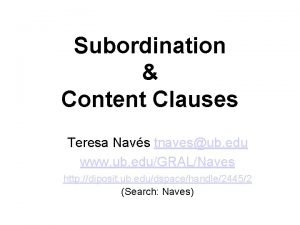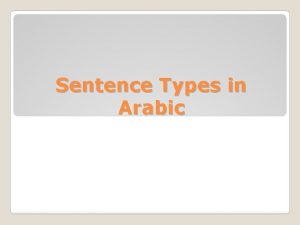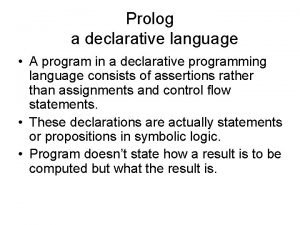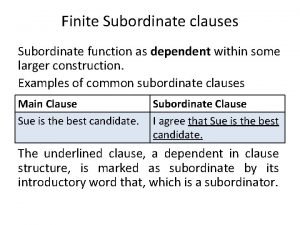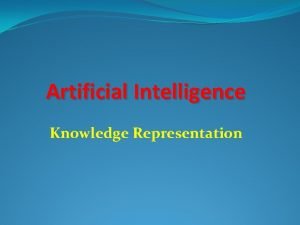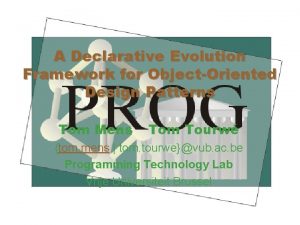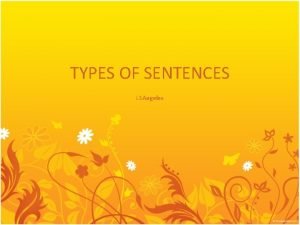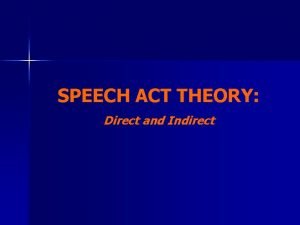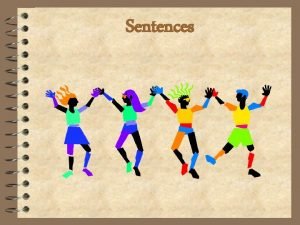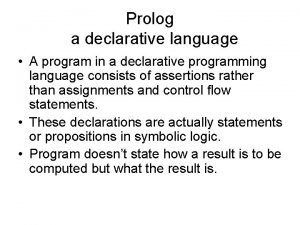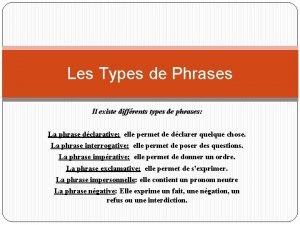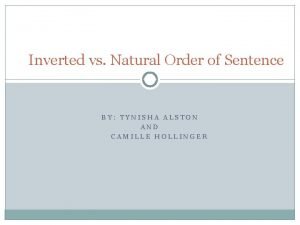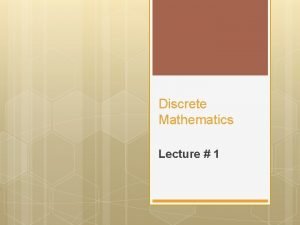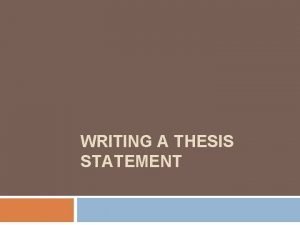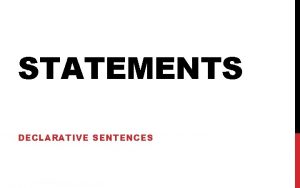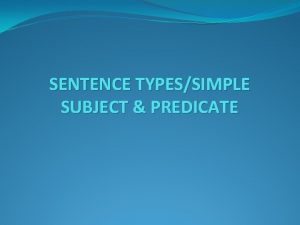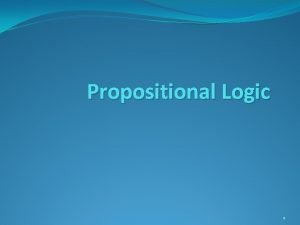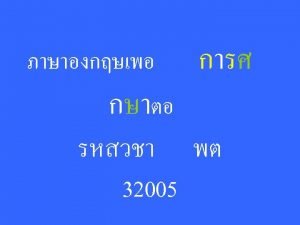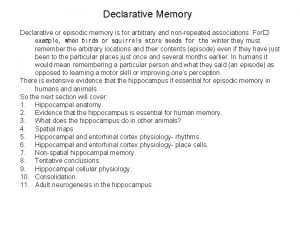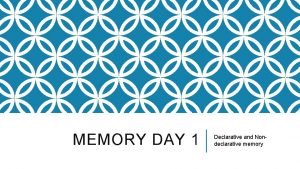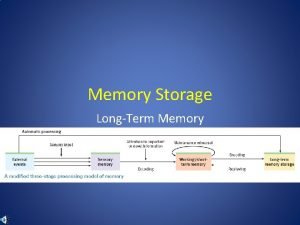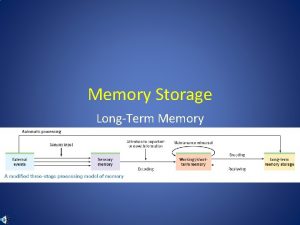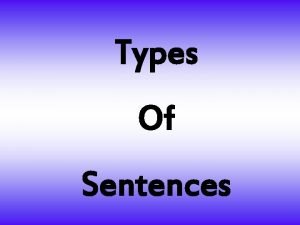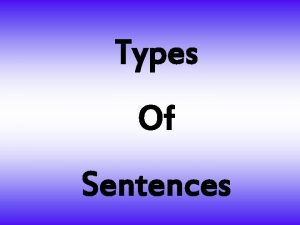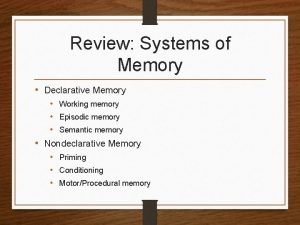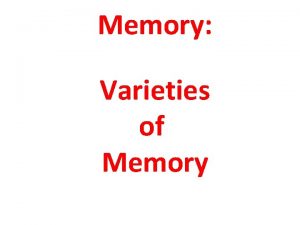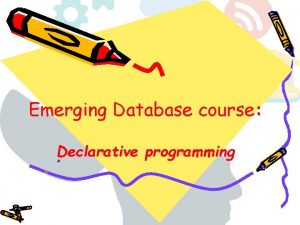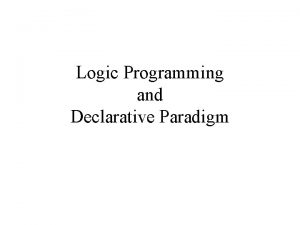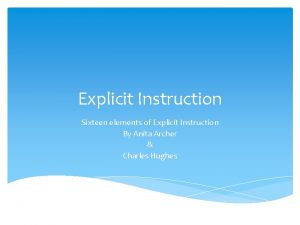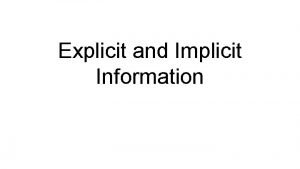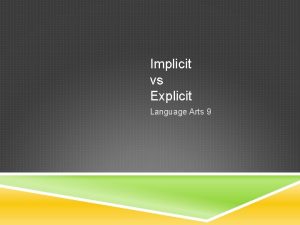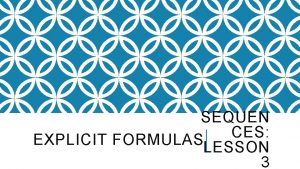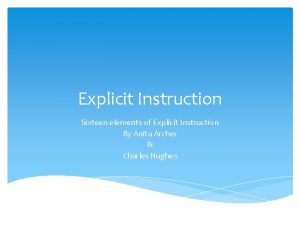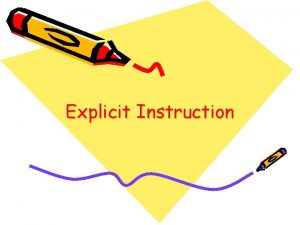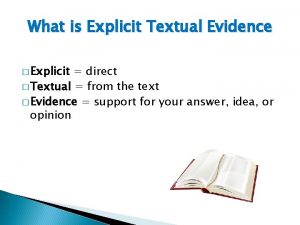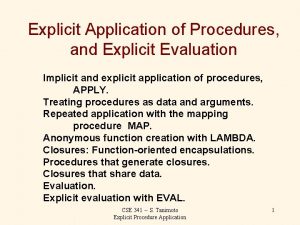Types of Longterm Memory Explicit memory zaka Declarative











































- Slides: 43

Types of Long-term Memory

Explicit memory zaka Declarative or Conscious memory z. Memory consciously recalled or declared z. Can use explicit memory to directly respond to a question z. Two subtypes of explicit memory

Subtypes of Explicit Memory

Episodic memory z Memory tied to your own personal experiences z Examples: y. What month is your birthday? y. Do you like to eat caramel apples? z Q: Why are these explicit memories? z A: Because you can actively declare your answers to these questions

Semantic memory z. Memory not tied to personal events z. General facts and definitions about the world z. Examples: y. How many tires on a car? y. What is a cloud? y. What color is a banana?

Semantic memory z Q: Why are these explicit memories? z A: Because you can actively declare your answers z Important note: Though you may have personal experience with these items, your ability to answer Q’s does NOT depend on tying the item to your past yi. e. Do not have to recall the time last week when you ate a banana to say that bananas are yellow

Implicit memory z. Aka nondeclarative memory z. Influences your thoughts or behavior, but does not enter consciousness z. Three subtypes

Subtypes of Implicit Memory

Classical conditioning z Pavlov z Previously neutral stimulus now comes to elicit a response after pairing with an unconditioned stimulus Natural reflex Neutral stimulus + UCS (food in mouth) (ringing bell) UCR (salivation) Conditioned reflex CS (ringing bell) CR (salivation)

Procedural memory z Memory that enable you to perform specific learned skills or habitual responses z Examples: y Riding a bike y Using the shift stick while driving y Tying your shoe laces z Q: Why are these procedural memories implicit? z A: Don’t have to consciously remember the steps involved in these actions to perform them y Try to explain to someone how to tie a shoelace

Priming z Pass out demonstration sheets

Priming demonstration z Unscramble the following word: z. L T E P A z Answer: z. P E T A L z. P L A T E

Priming z. Why did half the class say plate and the other half say petal? z. They were primed to do so z. There were two different sheets of unscrambled words

Priming sheet 1 z Unscramble the following word: z. F I N E K z. O P O N S z. K R O F z. P U C z. E C U S A R z. L T E P A z Answer: z. K N I F E z. S P O O N z. F O R K z. C U P z. S A U C E R z. P L A T E

Priming sheet 2 z Unscramble the following word: z. N Y P A S z. F E L A z. K T A L S z. D U B z. L O B S O M S z. L T E P A z Answer: z. P A N S Y z. L E A F z. S T A L K z. B U D z. B L O S S O M z. P E T A L

Priming z Do priming demonstration

Priming Seeing the word rabbit Activates concept Primes spelling the spoken word hair/hare as h-a-r-e

Priming z. Activation of one or more existing memories by a stimulus z. Activation not a conscious decision z. BUT, can effect subsequent thoughts and actions z. Two types of priming

Two types of priming

Conceptual priming z When priming stimulus influences your flow of thoughts z Thought to involve activation of concepts stored in semantic memory z Example: Previous priming demonstration z Example: If you hear a story about a pitbull, when someone later asks you to name a dog, you’re more likely to say “pitbull”

Perceptual priming z. Can you identify the fragmented stimulus below?

Perceptual priming z What if you were shown the following slide earlier in the lecture?

Perceptual priming z Can you identify the fragmented stimulus to the right?

Perceptual priming z What if you were shown the following slide earlier in the lecture?

Perceptual priming z When a priming stimulus enhances ability to identify a test stimulus based on its physical features z Priming is implicit because you don’t need to consciously recall seeing the priming stimulus in order for priming to occur

Evidence for separate implicit/explicit systems? z. Neurophysiological evidence z. Patient H. M. y. Life-threatening seizures originating in temporal lobe ysurgically removed portions of temporal lobe

Temporal lobe z. Includes: yhippocampus yamygdala Temporal lobe Hippocampus

Patient H. M. z surgery was effective in reducing seizures z BUT, had other side effects as well z Can remember explicit memories acquired before the surgery y e. g. old addresses, normal vocabulary z Had difficulty forming NEW explicit memories y e. g. remembering the name of someone he met 30 minutes prior y cannot name new world leaders or performers

Hippocampal damage z Deficits in forming new explicit memories

Temporal lobe damage z. Monkeys and rodents with temporal lobe damage show similar patterns of deficits z. Impaired performance on a delayed-nonmatch-to-sample task that tests explicit memory

DNMTS task Delay. Phase Sample Choice Phase

Temporal lobe damage z. Not impaired on similar task that taps habit-based (implicit) memory

Habit-based task Trial One Two

Patient H. M. Summary z Temporal lobe damage led to deficits in explicit, but not implicit memory y H. M. had both episodic and semantic memory deficits z Damage to the hippocampus alone produces episodic, but not semantic memory deficits z Why did H. M. show both types of explicit memory deficits? y He had damage not only to hippocampus, but to other structures as well

Are memories organized? z Demonstration: z Recite the days of the week in alphabetical order z Demonstrates that long-term memory is organized ynot just a random jumble of information z How are memories organized?

Demonstration z List of words will be read one at a time z Recall as many words as possible

Demonstration z Look at your sheet z Is there a pattern to your answers? z Most list several fruits, then vehicles, then furniture (or vice versa)

How are memories organized? z. Hierarchical organization z. Associations

Hierarchical organization z Related items clustered together to form categories z Related categories clustered to form higherorder categories z Remember list items better if list presented in categories y poorer recall if presented randomly z Even if list items are random, people still organize info in some logical pattern

Hierarchical organization

How are memories organized? z. Hierarchical organization z. Associations

Spreading activation model z Mental links between concepts ycommon properties provide basis for mental link z Shorter path between two concepts = stronger association in memory z Activation of a concept starts decremental spread of activity to nearby concepts

Spreading activation model Car Truck Bus Fire Engine House Fire Ambulance Red Hot Rose Violet Apple Flower Cherry Pear Stove Pot Pan Pie
 Pozorovací arch žáka
Pozorovací arch žáka Implicit explicit memory
Implicit explicit memory Linux kernel longterm
Linux kernel longterm Thomas silverstein
Thomas silverstein Define long term memory
Define long term memory Declarative memory
Declarative memory Explicit and implicit memory
Explicit and implicit memory Implicit memory
Implicit memory Explicit memory psychology example
Explicit memory psychology example Memory is the ability to
Memory is the ability to Example of explicit memory
Example of explicit memory Memory storage is never automatic; it always takes effort.
Memory storage is never automatic; it always takes effort. Implicit vs explicit memory
Implicit vs explicit memory Example of explicit memory
Example of explicit memory Implicit vs explicit memory
Implicit vs explicit memory Miller's magical number 7 study
Miller's magical number 7 study Confabulation psychology definition
Confabulation psychology definition Explicit memory allocation
Explicit memory allocation Imperative declarative exclamatory
Imperative declarative exclamatory The four kinds of sentences
The four kinds of sentences Declarative content clause
Declarative content clause Sentence types
Sentence types Declarative interrogative
Declarative interrogative Prolog is a declarative language
Prolog is a declarative language Recursive pattern
Recursive pattern Declarative content clause
Declarative content clause Declarative interrogative imperative exclamatory sentences
Declarative interrogative imperative exclamatory sentences Procedural versus declarative knowledge in ai
Procedural versus declarative knowledge in ai Declarative design pattern
Declarative design pattern 5 example of declarative sentence
5 example of declarative sentence Speech acts direct and indirect
Speech acts direct and indirect Whats a compound sentence
Whats a compound sentence Prolog is a declarative language
Prolog is a declarative language Compare procedural semantics and declarative semantics.
Compare procedural semantics and declarative semantics. Types of knowledge in artificial intelligence
Types of knowledge in artificial intelligence Une phrase graphique
Une phrase graphique Une phrase déclarative
Une phrase déclarative Inverted complex sentence
Inverted complex sentence Declarative statement in discrete mathematics
Declarative statement in discrete mathematics What is a declarative thesis statement
What is a declarative thesis statement Predicate pronoun sentences
Predicate pronoun sentences Simple subject and simple predicate examples
Simple subject and simple predicate examples Examples of a proposition
Examples of a proposition Declarative sentence ex
Declarative sentence ex
